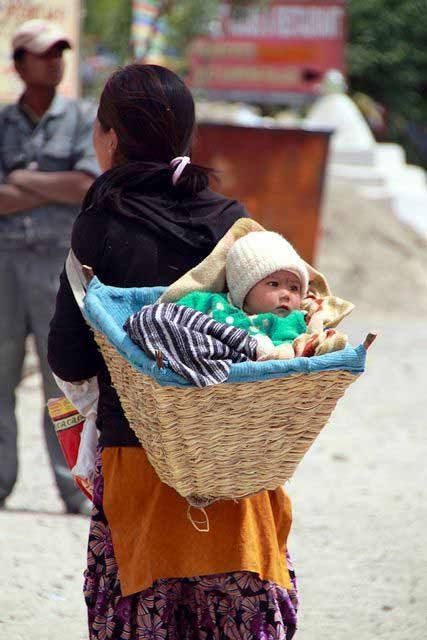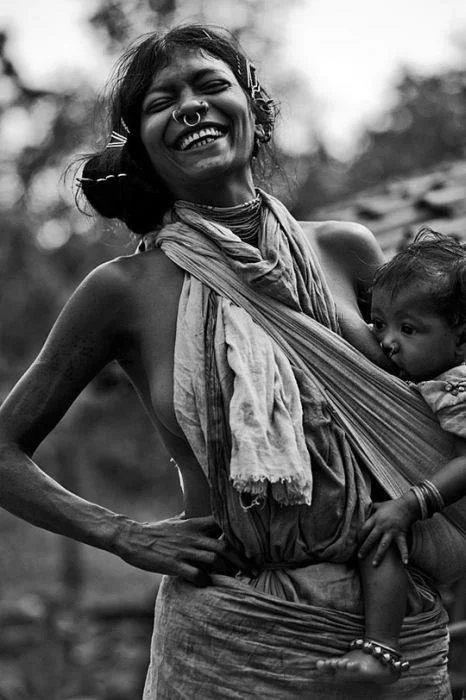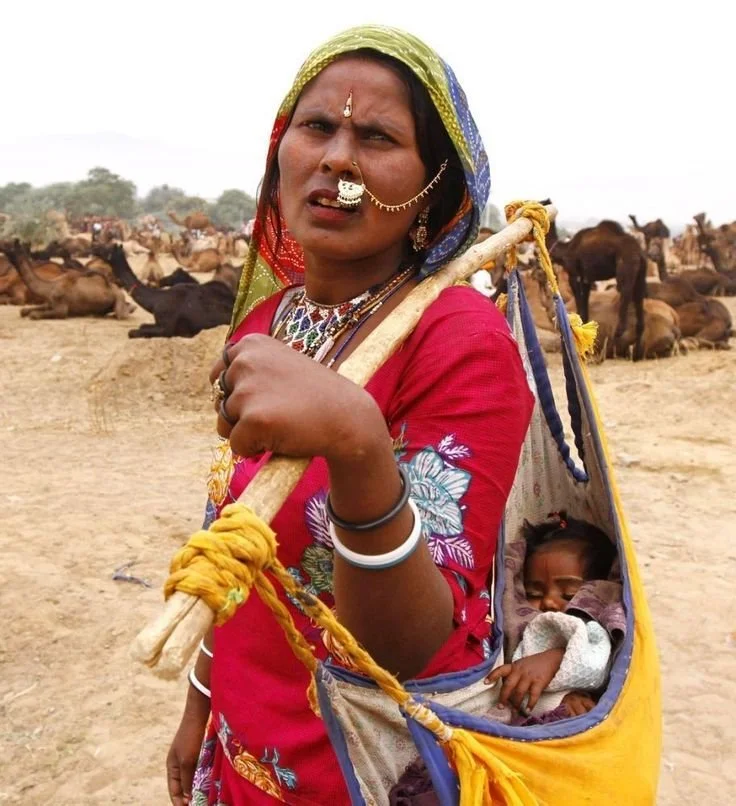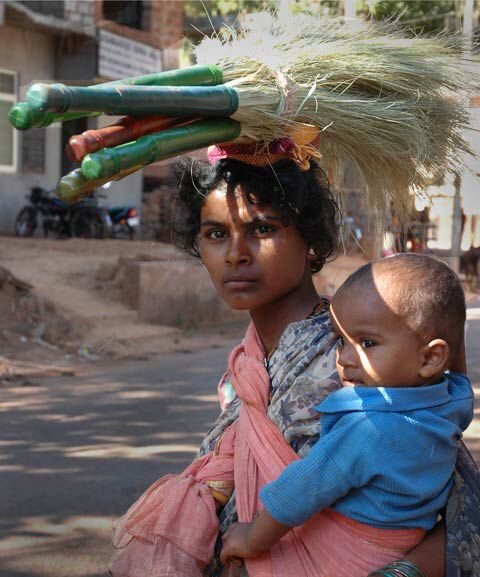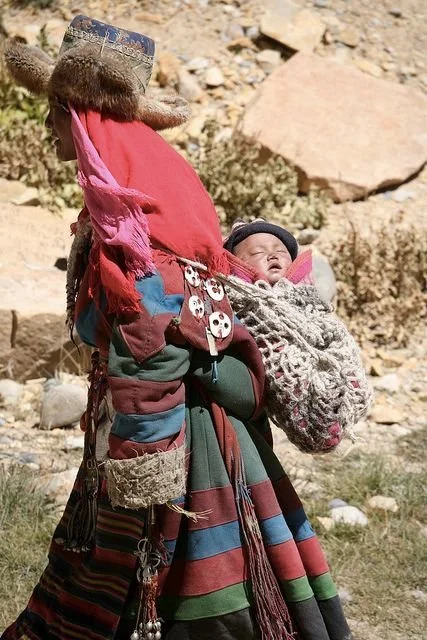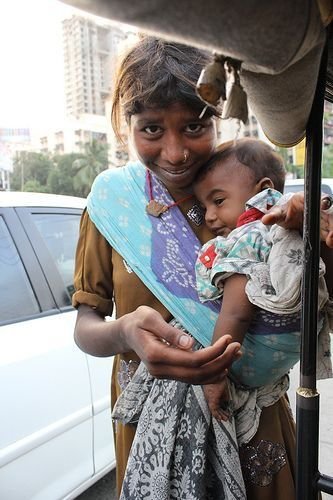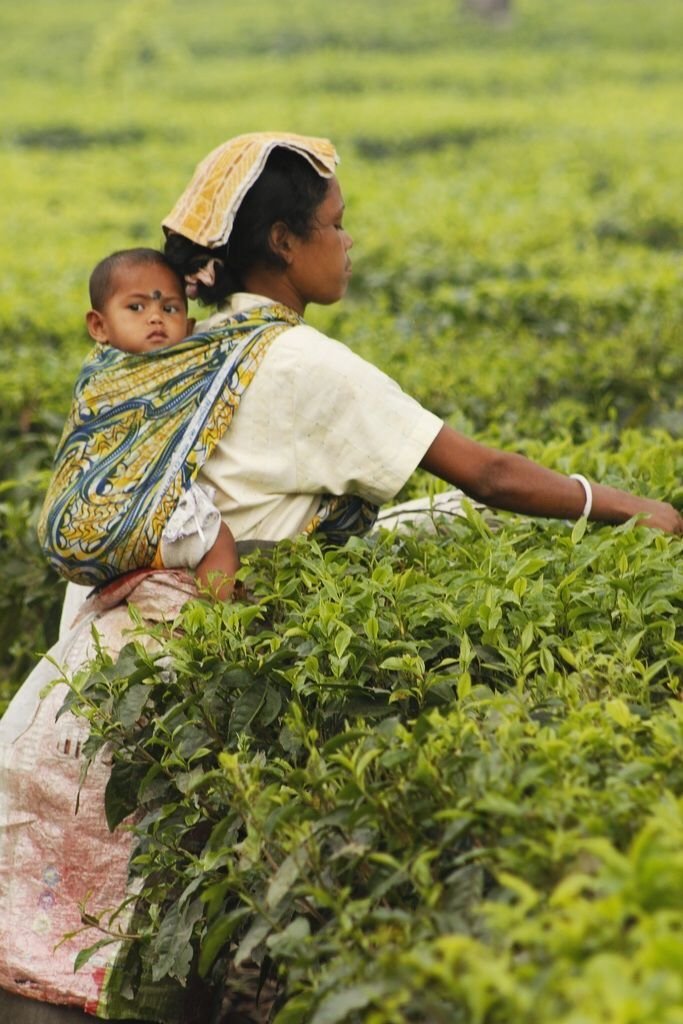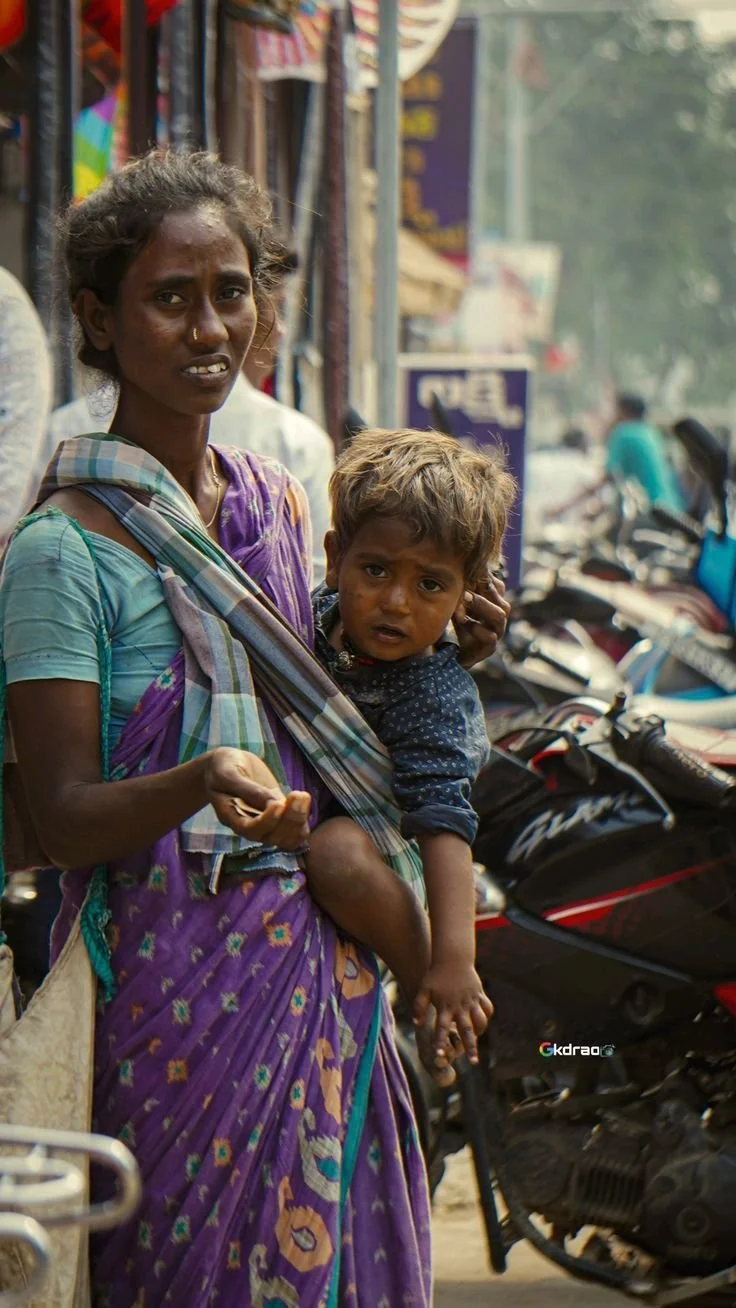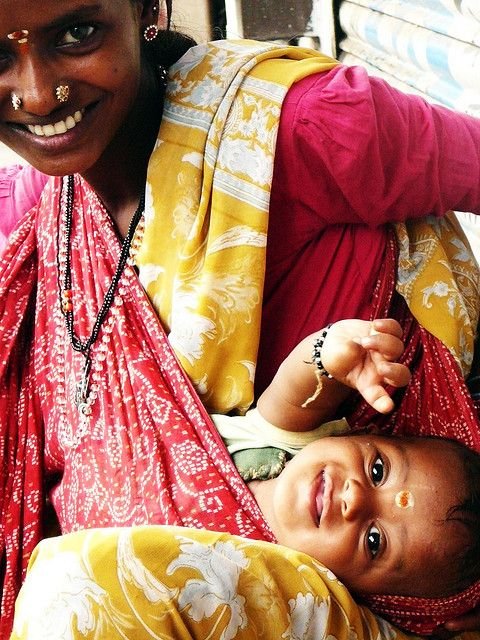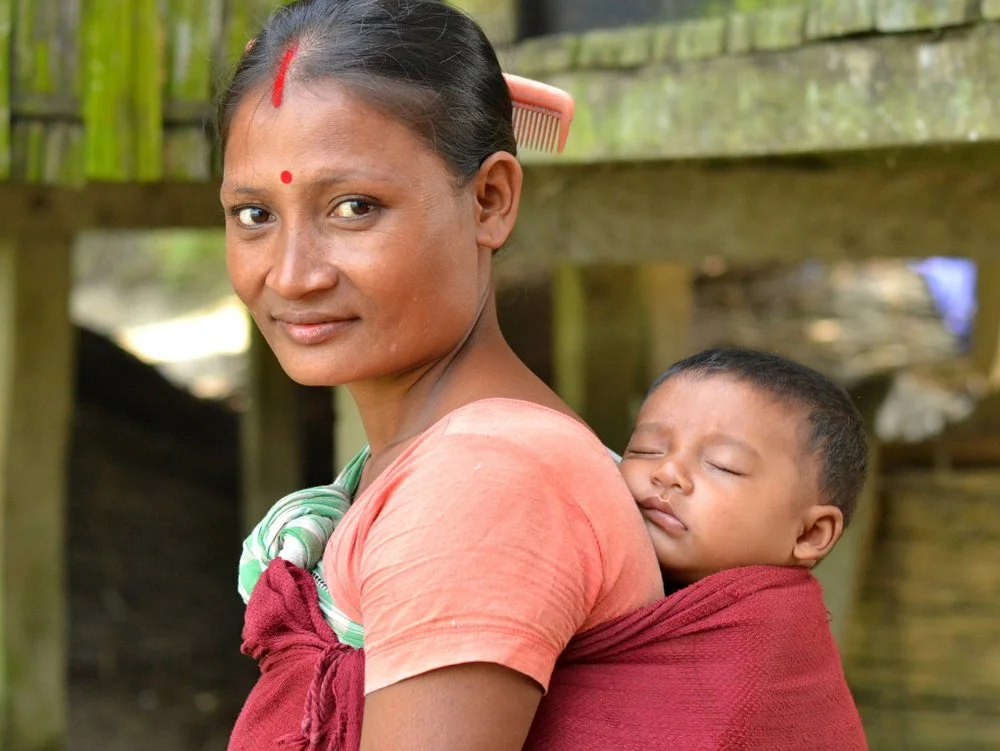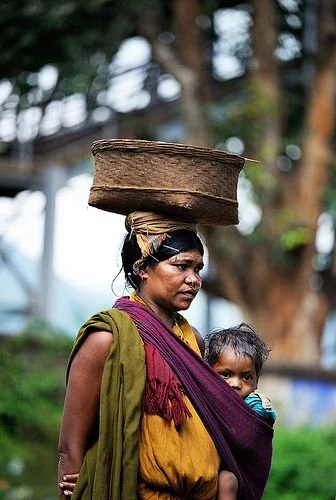South Asia: Sari Ends and Sacred Threads
Across South Asia — a region encompassing India, Nepal, Bangladesh, Sri Lanka, Bhutan, and beyond — babywearing traditions are as diverse and vibrant as the people and landscapes themselves. These traditions often center around everyday cloths: saris, dupattas, shawls, and regional wraps that reflect centuries of artistry and practical wisdom.
In many rural and tribal communities in India, mothers have long used the end of a sari or a length of cloth to carry their babies on the hip or back. These improvised carriers, tied securely, allow women to continue working in fields, cooking, or tending to household tasks while keeping their babies close enough to feel their warmth and hear their voices. The baby becomes an integral part of daily rhythms, learning about life from the gentle sway and constant presence of their caregiver.
Among tribal and indigenous communities — such as those in Odisha, Assam, and northeastern states — carrying methods often involve handwoven cloths unique to each group. These textiles are rich with meaning, with motifs symbolizing protection, fertility, or the natural world. The weaving itself is an act of devotion and cultural preservation, passed from one generation to the next.
In Nepal and the Himalayan foothills, mothers use shawls or wraps called bhako or patuka to carry babies, especially during agricultural work or mountain treks. The cloth is tied high and snug to the back, allowing the caregiver to navigate steep, rugged terrain with confidence. Babies share in the sweeping views of terraced fields and snow-capped peaks, learning resilience and connection from their earliest days.
Despite the long-standing richness of these practices, modern influences — including the popularity of prams and the pressures of urban life — have shifted carrying traditions in many South Asian cities. However, in rural areas and among those reclaiming ancestral ways, these methods persist as symbols of cultural pride and maternal strength.
To carry a baby in South Asia is to wrap them not just in cloth, but in story: a story of mothers and grandmothers, of fields and festivals, of prayers whispered into soft fabric. Each knot and fold is a quiet blessing, a promise of safety and belonging held close to the heart.
Nepal
In this image, a mother carries her baby in a large woven basket on her back, a style seen in parts of Nepal and other Himalayan regions. The baby is warmly wrapped and cushioned with blankets inside the basket, which is secured with a strap across the mother's forehead or shoulders, distributing the weight evenly. This type of carrying system, sometimes called a "doko," is traditionally used for transporting goods but is also adapted for carrying children in these mountain communities. It reflects the practical, resourceful approaches to babywearing that blend daily work and caregiving seamlessly, allowing parents to keep their babies close and safe while navigating rugged terrain.
India
Among many Adivasi (Indigenous) communities of India, mothers carry their babies in soft handwoven cloths tied simply across the shoulder and chest. Here, a mother’s radiant smile shines as her child nurses, both wrapped in a sling that speaks of deep resourcefulness and love. The simplicity of the cloth belies its power: it holds a baby close through forest paths, village gatherings, and the gentle rhythms of daily life. In every knot and drape, we see the quiet strength of women who carry not just their children, but their traditions, songs, and hopes — woven into each step.
Rajasthan, India
In Rajasthan’s vast desert plains, mothers weave practicality and beauty into their daily lives. Here we see a mother carrying her sleeping child in a cloth cradle suspended from a wooden pole — a testament to ingenious design born from nomadic traditions. The baby rests in a soft hammock, shaded and gently swayed with each step, while the mother moves through the dusty camel fair with ease. Her adornments tell a story of identity and heritage, just as her carrier speaks of generations of adaptation to harsh sun, long journeys, and the constant need to keep little ones close. In these communities, the art of carrying is as fluid and rhythmic as the desert winds themselves.
India
This striking image shows a mother in India carrying her baby on her hip in a simple cloth wrap while balancing a large bundle of broom grasses and tools on her head. The baby sits upright and alert, facing outward and sharing in the day’s sights and sounds. Her strong, steady gaze and confident posture beautifully capture the resilience and quiet power of mothers everywhere. The vibrant cloth wrap and sari details reflect India’s rich textile heritage, where practicality and beauty come together. This powerful scene reminds us that babywearing is not just about carrying a child — it is a testament to a mother’s strength, adaptability, and unwavering connection with her little one.
Ladakh, India
This striking photo captures a woman from Ladakh, India, wearing her beautifully layered traditional attire, including a distinctive perak headdress adorned with turquoise stones. On her back, her baby rests in a loosely woven woollen carrier, keeping them snug and secure while allowing airflow in the high-altitude desert climate. The bright, bold textiles and silver ornaments reflect regional identity and pride. This image beautifully illustrates how babywearing adapts to cultural dress and environment, supporting both mother and child in daily life."
India
This tender street scene from India shows a young mother carrying her baby close in a traditional cloth sling, likely fashioned from a dupatta or sari. With effortless resourcefulness, she has tied the fabric across her shoulder and around her body, supporting her baby securely while keeping her hands free. This way of carrying reflects the deeply rooted cultural value of keeping infants close to the heart, offering warmth, comfort, and constant connection. The bright colors and soft drape of the cloth highlight the beauty and adaptability of traditional textiles in everyday life, celebrating the universal bond between mother and baby.
Assam, India
In the tea gardens of Assam, India, mothers often carry their babies on their backs using a simple cloth or saree, knotted securely to keep them close while they work. This practice ensures babies remain part of the daily flow of life, enveloped by the scent of tea leaves and the sounds of the fields. The wrap becomes more than a tool — it is an extension of the mother’s embrace, providing comfort, warmth, and a sense of belonging. Here, carrying a baby in this way reflects the resilience and quiet strength woven into everyday labor and care.
India
In this image, a mother from South India — likely Tamil Nadu — carries her child on her hip, supported by an extra cotton cloth draped over her shoulder and around her back. The sari, wrapped with vibrant purple patterns, and the simple sling reflect a deeply practical, everyday elegance woven into Indian family life. In bustling urban streets and busy markets, mothers move fluidly through crowds while keeping their children close and safe, ready to comfort or feed them at a moment’s notice. This carrying style is more than a technique; it is an expression of continuous connection and resilience, embodying the belief that children should be held within the heartbeat of daily life — watched over, included, and loved through every step.
India
A mother in India smiles warmly, her vibrant saree wrapped not only around her body but also forming a secure sling for her baby. The fabric, richly patterned in red and gold, cradles the child against her side in a traditional front carry that allows closeness, visibility, and ease of movement. The baby, adorned with a bindi and black bracelets for protection, gazes joyfully toward the camera, upside-down from the viewer’s perspective but clearly content and secure. This moment captures both cultural richness and the instinctive bond shared between mother and child — a blend of color, connection, and care woven into everyday life.
Assam, India
In this vibrant photograph, we see women from the Karbi community in Assam, India — an Indigenous group from the Northeastern region known for their rich textile traditions and strong communal practices.
Here, the mothers are carrying their children using simple but effective cloth wraps, sometimes called “upa kheni” among certain hill tribes. These wraps are often made from traditional handwoven textiles that reflect local patterns and colors, such as checks and stripes in deep reds and bright hues.
Assam, India
In this warm and intimate portrait, an Assamese mother from Northeast India carries her sleeping baby on her back using a traditional cloth wrap. The wrap — in deep maroon and soft green tones — is carefully tied across her chest and shoulders, supporting the baby snugly and securely.
The mother’s serene expression, gentle smile, and direct gaze create a powerful sense of presence and quiet pride. Her red bindi and hair comb tucked into her neatly tied hair reflect elements of her cultural identity and daily life.
India
In this striking photograph, an Adivasi mother from eastern India — likely from one of the indigenous tribal communities of Odisha — carries her child close against her chest in a simple, skillfully wrapped cloth carrier. The deep, earthy hues of her sari and wrap reflect her connection to the land and local textiles.
The cloth is tied securely over her shoulder, supporting her child in an upright, heart-to-heart position that fosters constant contact and security. The mother’s adornments — including her traditional nose jewelry and forehead markings — highlight her cultural identity and community belonging. The woven basket balanced expertly on her head, padded with a coiled cloth, showcases her strength and the simultaneous responsibilities she manages with grace.
Among many tribal groups in Odisha, such carrying practices are woven into daily life. They allow mothers to continue agricultural or market work while keeping their babies safe and soothed, embodying a deep, generational wisdom of responsive care.
This image beautifully captures the essence of babywearing as an enduring, tender expression of love and resilience, echoing the intimate rhythms of traditional life.
India
In this striking image, a Baiga mother from Madhya Pradesh carries her baby close in a bright orange cloth sling. The vivid color of her traditional draped garment, paired with her bangles and hair pin, celebrates her cultural heritage and personal expression.
The sling is wrapped securely over one shoulder and across her chest, supporting the baby snugly against her body. The child looks outward calmly, nestled in the protective curve of the mother's arm, while she holds an additional cloth in her hand, perhaps for wiping or shading.
This scene beautifully captures the balance of care and daily life among Baiga women. The simple yet skillful sling method allows mothers to remain active while fostering closeness, offering a powerful glimpse into the enduring connection and resilience found in traditional babywearing practices.
Bhutan
In this vibrant street scene, a Bhutanese mother carries her child on her back using a traditional woven cloth wrap. The rich orange and red tones of the carrier echo the warm colors often seen in Bhutanese textiles and architecture, beautifully complementing her red shirt and patterned kira (traditional wrap skirt).
The little girl peeks curiously over her mother’s shoulder, her bright expression framed by the soft, snug wrap that supports her comfortably while allowing her to observe the world around them. The mother stands poised and calm, her stance embodying the confidence and ease that come with practiced babywearing.
In Bhutan, woven cloth carriers are widely used, reflecting deep cultural values of closeness, community, and practical artistry. This image captures both the strong bond between mother and child and the enduring beauty of Bhutanese craftsmanship and daily life.
Bhutan
An elder from Bhutan carries a young child on his back using a woven cloth tied securely over his shoulders. The child, dressed in traditional striped kira-style fabric, rests comfortably close, peering curiously at the world around them.
In Bhutanese culture, it’s common for grandparents and elders to help care for young children, and using a simple cloth or shawl as a carrier is a time-honoured, practical way to keep them safe and connected. This method allows the caregiver to move freely, share warmth, and maintain a sense of closeness and community — reflecting the deep intergenerational bonds that are such an important part of life in Bhutan.
A note of gratitude and respect
We respectfully acknowledge and honor the individuals and communities depicted in historical images throughout this series. Many of these photographs were taken in times and contexts where informed consent as we understand it today was not sought or given, and some may have been created through coercion or exploitation.
We share these images with the deepest gratitude, not to romanticize or objectify, but to recognize and celebrate the strength, resilience, and wisdom of these cultural practices. We hold these ancestors and knowledge holders in our hearts and aim to represent their traditions with integrity, humility, and care.
We commit to continuing to learn, listen, and uplift the voices of contemporary community members and descendants, and we welcome guidance on the respectful sharing of these images.

